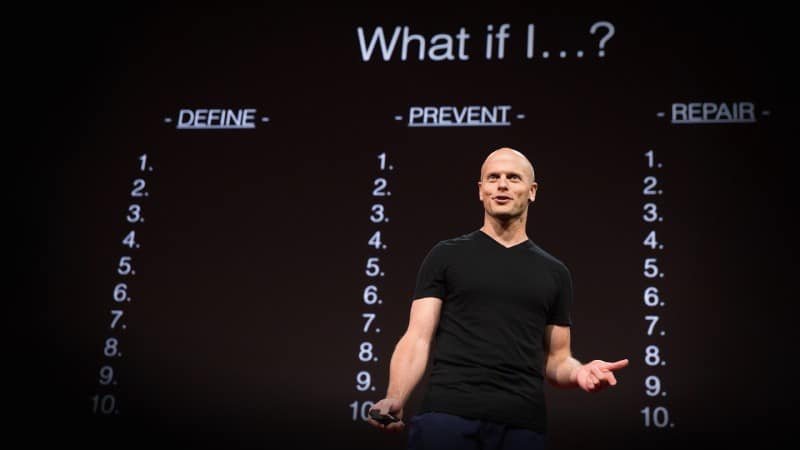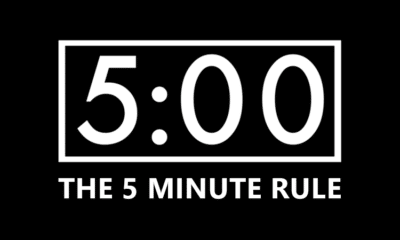Success Advice
Fear-setting: Why you should define your fears instead of your goals
Published
5 years agoon

Fear-setting is an exercise that Tim Ferriss swears by. The bestselling author of The 4 Hour Work Week says he does fear-setting at least once a quarter and that it’s the most powerful exercise he does.
“Fear-setting has produced my biggest business and personal successes, as well as repeatedly helped me to avoid catastrophic mistakes.” – Tim Ferriss
What Is Fear-setting?
So what is fear-setting and why should you start doing this exercise too?
Fear-setting is a term coined by Ferriss based on the stoic premeditatio malorum—the premeditation of the evils and troubles that might lie ahead. It’s the exercise of imagining things that could go wrong or be taken away from you. In doing so It helps you prepare for life’s inevitable setbacks.
Some have called Stoicism the ultimate self-improvement philosophy and at its core it about training yourself to separate what you can control from what you cannot control, enabling you to reduce your emotional reactivity.
A quick side note – if you haven’t already started practicing Stoicism it’s definitely worth doing so. The great Stoics of the past include the likes of Marcus Aurelius, Seneca, and even the founding fathers of the United States such as George Washington and Thomas Jefferson.
Fear of the unknown holding you back?
Why should you define your fears instead of your goals? Well you should be doing both.
We know how powerful goal setting can be, especially when it comes to having clearly defined written goals and plans to achieve them.
The problem is though a lot of people set goals, they set resolutions and they never follow through with consistent action.
For years I was stuck in an endless cycle where I would set goals, take a bit of action, procrastinate endlessly, find new inspiration, set even bigger goals, resolve to be successful, procrastinate endlessly, find new inspiration, set even bigger goals…
Nothing ever changed. I lost a decade of my life like this.
My self-esteem was destroyed, I lost my confidence but at some level I still believed that I could be, do and have more. I just couldn’t get myself to take consistent action on anything meaningful.
I was great at keeping busy and paying the bills but I was so far off from actually achieving my goals. I was stuck, I was paralyzed by fear and I was distracting myself with anything I could — TV, social media, research and meaningless work.
If you find yourself setting goals and resolutions but never taking consistent action on them then you’re avoiding pain — you’re afraid.
Afraid of what specifically? Most people can’t even define it. They’re afraid of the unknown.
While most people are not even conscious of their fears maybe you do know what you’re afraid of. The problem is that things are always a lot scarier in your head than they are in reality.
“We suffer more often in imagination than in reality” – Seneca
Conquering Fear = Defining Fear
As Jim Rohn says “When you describe life to yourself only in your mind, your imagination tends to feed back false information about how things really are. You may be working with distorted information.”
Enter the exercise of fear-setting.
Visualize the worse case scenarios preventing you from taking action so that you can take action and overcome that paralysis.
It was only when I started doing a similar exercise to fear-setting that I started to make progress. It was only when I started asking myself some of the same questions Tim Ferriss asks himself that I gained clarity and urgency to change.
Now it’s your turn. Watch the video below and follow the steps.
Tim Ferriss Fear-setting Ted Talk
One of the most profound Ted Talks you’ll probably ever watch is on the exercise of Fear-setting by Tim Ferriss.
Fear-setting Exercise
For the three exercise slides from the TED presentation, Tim kindly offers the download on his website. Please click here.
IMPORTANT: Make sure you write down your answers on paper. Simply thinking about the answers won’t work. You need to do a big brain dump on paper for this exercise to be effective.
Step 1: Ask yourself “What if I…?”
Ask yourself what if you do start a business, travel, ask out that person,… Whatever it is that you have been procrastinating on, whatever it is that has you paralysed with inaction, whatever it is that you have been avoiding.
Step 2: Define
Write down all the worst imaginable thing that can happen if you take action. Try to come up with 10 to 20 things.
Write down whatever comes up and don’t censor yourself. You’re defining all your fears and everything that could possibly go wrong so exhaust every possible thing you would want to avoid. Go into detail. Would it be the end of your life? What would be the permanent impact, if any, on a scale of 1–10? Are these things really permanent?
Step 3: Prevent
Ask yourself: “What could I do to prevent each of those worst-case scenarios from happening or at least decrease the likelihood of it happen, even a little bit?”
So go through each of your worst-case scenarios one by one and come up with a preventative solution.
How likely are each of your fears likely to happen if you take preventative measures?
Step 4: Repair
Assuming the worst-case scenario has happened what could you do to repair the damage, even a little bit or who could you ask for help?
Go through the list again, one by one, and come up with a solution for each to repair the damage.
The question to keep in mind as you do step 4 is: “Has anyone in the history of time, less intelligent or less driven figured this out?”
The chances are the answer is yes.
Step 5: The Benefits Of Taking Action
Ask yourself: “What might be the benefits of an attempt or partial success?”
Spend 10-15 minutes on this and really look at how it would benefit all areas of your life. Your emotions, your health, your relationships, your finances…
Step 6: The Cost Of Inaction
Now write down everything it will cost you if you don’t take action.
What will it cost you in 6 months?
What will it cost you in 1 year?
What will it cost you in 3 years?
What will it cost you emotionally, physically, financially… If you don’t take action on this now and if you keep doing what you’ve been doing?
It’s really important as you do this step that you clearly see all the possible things it will cost you if you don’t take action and get emotional about it.
This is probably the most important step in overcoming your paralysis. Tim Ferris says: “We are good at seeing what could go wrong if we take action, but we’re not very good at seeing what could go wrong if we do nothing.”
Step 7: Take Action
What are you waiting for? If you cannot answer this without resorting to the previously rejected concept of good timing, the answer is simple: You’re afraid, just like the rest of the world. Measure the cost of inaction, realize the unlikelihood and repairability of most missteps, and develop the most important habit of those who excel and enjoy doing so: action.
Summary: Start Fear-setting Today
Facing your fears, defining your fears, and exploring the worst-case scenarios isn’t comfortable but its a necessary step if you’re ever going to overcome them and move forward.
The key is to be willing to ask yourself the questions and writing your answers down on paper. The magic that happens when you write down your thoughts on paper is that you can now be objective.
The fact that it is now on paper actually creates space between you and the problem. And in the space that you have created, new solutions have room to grow.
Ferris says: “The hard choices, what we most fear doing, asking, saying, these are very often what we exactly need to do and the biggest challenges and problems we face will never be solved with comfortable conversations, whether it’s in your own head or with other people.”
“Easy choices, hard life. Hard choices, easy life.” – Jerzy Gregorek
What we fear doing most is usually what we most need to do. As I have heard said, a person’s success in life can usually be measured by the number of uncomfortable conversations he or she is willing to have. Resolve to do one thing every day that you fear.
Where in your life right now might defining your fears be more important than defining your goals?
I'm the Founder of SucceedFeed.com and I truly appreciate you taking the time to read my posts and being apart of the Succeed Feed community. I started this website because I wanted to help people like you to maximize your potential and achieve your dreams. Feel free to reach out and connect. If I can be of any help to you on your journey I'll do my best.











